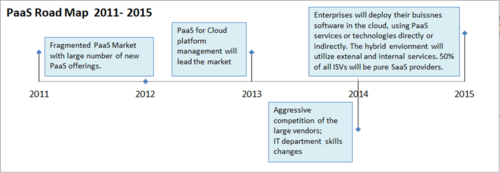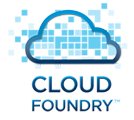> > > > > Market Overview and Definitions
According to Gartner’s PaaS Road Map report, cloud-based solutions will grow at a faster rate than on-premises solutions. By 2015, 50% of all ISVs will be SaaS providers. Most enterprises will hold major part of their business applications running on the cloud computing infrastructure, using PaaS and SaaS technologies directly or indirectly.
It is confusing to describe PaaS as one category as there are different values presented by the different ISVs whom developing and delivering solutions on different layers. Gartner’s report lets categorize the market of PaaS into the following 3 layers –
- Application platform as a service (aPaaS) – providing a complete application platform that is used by the actual application’s components (those which support the business process) or by its APIs. Business-level power users and developers gain speed-to-market and the ability to focus on bringing their expertise to the business process layer rather than having to build the whole application infrastructure.
- Software infrastructure as a service (SIaaS) – those services provide management for software parts such as online cloudy database, integration and messaging. This layer is similar to the previous layer as it provides the development tools to build an application in the cloud, but it’s targeted at developers rather than business-level power user.
- Cloud enabled application Platform (CEAP) – Software middle-ware tothat support the public and private cloud characteristics including monitoring, complexity management, scaling and optimization.
There’s been a veritable explosion of platform-as-a-service choices coming onto the market in the past month or two, and the pace of introductions is accelerating.
During the next two years, today’s segmented PaaS offering market will begin to consolidate into coalition of services targeting the prevailing use patterns for PaaS. Making use of such reintegrated, targeted suites will be a more attractive proposition than the burdensome traditional on-premises assembly of middleware capabilities in support of a project. By 2015, comprehensive PaaS suites will be designed to deliver a combination of all specialized forms of PaaS in one integrated offering.

> > > > > PaaS Providers and Products —
There are several well-known PaaS providers such as GoogleApps, Heroku, Microsoft Azure and of course Force.com, the most mature and rich PaaS for those who want to build a classic forms-and-database SaaS application in the “old” Salesforce.com fashion.
“We don’t spend any time talking about the acronyms,” Andy Jassy, senior vice president of AWS, told eWEEK. “All those lines will get blurred over time. It’s a construct to box people in and it fits some stack paradigm. We started with raw storage, raw compute, and raw database in SimpleDB. And we’ve added load balancing, a relational database, Hadoop and Elastic Map reduce, a management GUI… All those lines start to get blurred, and you can expect to see additional abstraction from us.” Read more on eWeek
 SpringSource (by VMWare) – Cloud Foundry, VMWare PaaS offering works with a variety of development frameworks and languages, application services and cloud deployment environments. It includes the SpringSource Framework, an enterprise Java programming model that VMware picked up in its August 2009 acquisition of SpringSource. The Spring Framework is in use by about 2 million developers worldwide as a lightweight programming environment to make applications portable across open-source and commercial application server environments. Read more on crn.com
SpringSource (by VMWare) – Cloud Foundry, VMWare PaaS offering works with a variety of development frameworks and languages, application services and cloud deployment environments. It includes the SpringSource Framework, an enterprise Java programming model that VMware picked up in its August 2009 acquisition of SpringSource. The Spring Framework is in use by about 2 million developers worldwide as a lightweight programming environment to make applications portable across open-source and commercial application server environments. Read more on crn.com

Caspio – `Cloudy` online database platform to support online software development. One of the best features of Caspio is its “embed” feature which offers an embed code for a Caspio-based “datapage” much the same way that YouTube offers embed codes for its videos. Caspio handles blobs at the field level (in other words, there’s support for video, images, and other large binary objects) and supports SQL/API-based access to its databases. Caspio has a personal “version” that’s free but is limited to 2 data pages (essentially forms) and then starts at $40 per month for 10 datapages, 1 GB worth of data transfer and 1 GB of storage. There’s a corporate version that goes for $350 per month (more datapages, capacity, and “logins”) and several levels of subscription in-between. See how Caspio works or read more about this vendor on informationweek.com
![]()
Gigaspaces – Gigaspaces’ core product the Gigaspaces XAP is an enterprise-grade, end-to-end in-memory application server for deploying and dynamically scaling distributed applications. If an ISV or any IT organization needs to boost workload performance and has business-critical Java and .NET applications. that can be spread over a computational or data grid configuration, XAP can be a good option. GigaSpaces started as a firm that could manage a server’s local cache; it expanded to manage the combined cache of a cluster of servers, then figured out how to make that cache expandable by managing the cache as servers were added to the cluster. In its latest iteration, the GigaSpaces CEAP (Cloud Enablement Application Platform) makes application business logic elastic by managing its multiple moving parts in a shared memory system.The cloud-enabled platform allows “continuous scaling of application data and services. Think of Amazon style of SimpleDB scaling,” Nati Shalom, CTO and founder of GigaSpaces. Check out Gigaspaces.com and read the recent news brought to you by InformationWeek.com
![]() OrangeScape – OrangeScape is one of the 10 global companies featured in Gartner’s ‘PaaS competitive landscape’ report and also has been featured in all the PaaS reports of Forrester.As an aPaaS provider, Orangescape Studio offers an UI similar to modern Excel application so the business users can design an application by capturing various aspects of the application declaratively in an XML-like format which is then executed by the proprietary Orangescape virtual machine. The core of the virtual machine is their main platform, which is nothing but a rules engine that works on a complex networked data model. Read more on CloudAve
OrangeScape – OrangeScape is one of the 10 global companies featured in Gartner’s ‘PaaS competitive landscape’ report and also has been featured in all the PaaS reports of Forrester.As an aPaaS provider, Orangescape Studio offers an UI similar to modern Excel application so the business users can design an application by capturing various aspects of the application declaratively in an XML-like format which is then executed by the proprietary Orangescape virtual machine. The core of the virtual machine is their main platform, which is nothing but a rules engine that works on a complex networked data model. Read more on CloudAve
![]() Cordys – aPaaS vendor Delivering MashApps Cordys Process Factory (CPF) is a Web browser-based, integrated cloud environment for rapid Cloud Application Development. Cordys Process Factory allows users to use and sell Cloud Applications, and also subscribe for applications built by others in the Cloud Marketplace. All of this is achieved through visual modeling, without having to write code. Check out Cordys and read more on getApp.
Cordys – aPaaS vendor Delivering MashApps Cordys Process Factory (CPF) is a Web browser-based, integrated cloud environment for rapid Cloud Application Development. Cordys Process Factory allows users to use and sell Cloud Applications, and also subscribe for applications built by others in the Cloud Marketplace. All of this is achieved through visual modeling, without having to write code. Check out Cordys and read more on getApp.
There are other interesting PaaS providers such as Joyent, MuleSoft, CloudBees, Appistry and more, I will release another post on those later on this month so you are welcome to stay tuned with `I Am OnDemand`.
> > > > > Choose Your PaaS Providers
Traditional ISV conversion to become a pure SaaS vendor should carefully plan its application deployment strategy. By learning the PaaS Market and selecting its relevant vendors in this market the traditional ISV will present a fast go-to-market and eventually a smoother conversion. Together with those benefites, I find that the ISV consideration of using a PaaS provider will make the smart ISV’s CTO to understand the strong lock-in to whichever PaaS providers the CTO will choose. This will make the CTO nervous as the lock-in feature on the On-Demand market is with no doubt more aggressive.
Check those important criteria to consider in evaluation PaaS vendor.
Learn more about PaaS vendor lock-in
To summarize I can say that no doubt that PaaS has an important part in the adoption of cloud computing by the ISVs and the IT organizations. The PaaS players are technology-rich companies, the market definitions and roles are not completely clear and it seems that PaaS evolve slower than the other two layers (i.e IaaS and PaaS). As in every evolving new market you can expect a wave of innovation and of hype as there today new business opportunities for startups companies, the leading software vendors and the IaaS giants.
Do you still have a lack of knowledge with basic market definitions? Check I Am OnDemand Terminology Page
